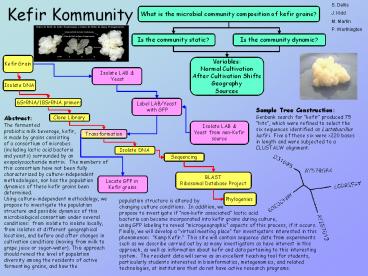Kefir Kommunity - PowerPoint PPT Presentation
Title:
Kefir Kommunity
Description:
Genbank search for 'kefir' produced 75 'hits', which were refined to select the ... propose to investigate if 'non-kefir associated' lactic acid ... – PowerPoint PPT presentation
Number of Views:240
Avg rating:3.0/5.0
Title: Kefir Kommunity
1
Kefir Kommunity
S. Dellis J. Kidd M. Martin P. Worthington
What is the microbial community composition of
kefir grains?
Is the community static?
Is the community dynamic?
Kefir Grain
Variables Normal Cultivation After Cultivation
Shifts Geography Sources
Isolate LAB Yeast
Isolate DNA
Label LAB/Yeast with GFP
16SrRNA/18SrRNA primers
Sample Tree Construction Genbank search for
kefir produced 75 hits, which were refined to
select the six sequences identified as
Lactobacillus kefiri. Five of these six were
gt220 bases in length and were subjected to a
CLUSTALW alignment.
Abstract The fermented probiotic milk beverage,
kefir, is made by grains consisting of a
consortium of microbes (including lactic acid
bacteria and yeasts) surrounded by an
exopolysaccharide matrix. The members of this
consortium have not been fully characterized by
culture-independent methodologies, nor has the
population dynamics of these kefir grains been
determined. Using culture-independent
methodology, we propose to investigate the
population structure and possible dynamics of
this microbiological consortium under several
conditions from isolate to isolate locally,
from isolates at different geographical
locations, and before and after changes in
cultivation conditions (moving from milk to grape
juice or sugar-water). This approach should
reveal the level of population diversity among
the residents of active fermenting grains, and
how the
Clone Library
Isolate LAB Yeast from non-Kefir source
Transformation
Isolate DNA
Sequencing
BLASTRibosomal Database Project
Locate GFP in Kefir grains
Phylogenies
population structure is altered by changing
culture conditions. In addition, we propose to
investigate if non-kefir associated lactic acid
bacteria can become incorporated into kefir
grains during culture, using GFP labeling to
reveal microgeographic aspects of this process,
if it occurs. Finally, we will develop a virtual
meeting place for investigators interested in
this phenomenon Kamp Kefir. This site will
contain sequence data from experiments such as
we describe carried out by as many investigators
as have interest in this approach, as well as
information about kefir and data pertaining to
this interesting system. The resident data will
serve as an excellent teaching tool for students,
particularly students interested in
bioinformatics, metagenomics, and related
technologies, at institutions that do not have
active research programs.































